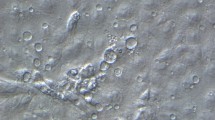Abstract
Most of theCoxiella burnetii isolates (72 of 80) available in our institute share a 2.1 kbNotI fragment. Sequence analysis revealed two incomplete open reading frames (ORF) for putative geneshemA andbcR coding for glutamyl-tRNA-reductase and bicyclomycin resistance protein, respectively. Upon completing the ORF for thehemA gene by sequencing the adjacentNotI/EcoRI fragment a third ORF for the putativeprfA gene was determined coding for release factor 1, an enzyme catalysing the last step in protein biosynthesis.
Similar content being viewed by others
References
Thiele D, Willems H. Is plasmid based differentiation ofCoxiella burnetii in ‘acute’ and ‘chronic’ isolates still valid? Eur J Epidemiol 1994; 10: 427–434.
Atzpodien E, Baumgärtner W, Artelt A, Thiele D. Valvular endocarditis occurs as a part of a disseminatedCoxiella burnetii infection in immunocompromised BALB/cJ (H-2d) mice infected with the Nine Mile isolate ofC. burnetii. J Infect Dis ; 170: 223–226.
Heinzen RA, Mallavia LP. Cloning and functional expression of theCoxiella burnetii citrate synthase gene in Escherichia coli. Infect Immun 1986; 55: 848–855.
Thiele D, Willems H, Haas M, Krauss H. Analysis of the entire nucleotide sequence of the cryptic plasmid QpH1 fromCoxiella burnetii. Eur J Epidemiol 1994; 10: 413–420.
Sawadogo M, van Dyke MM. A rapid method for the purification of deprotected oligodeoxynucleotides. Nucl Acids Res 1993; 39: 674.
Arens M. Vermehrung vonCoxiella burnetii durch persistierende Infektion in Buffalo-Green-Monkey(BGM)-Zellkulturen. Zbl Vet Med 1983; B30: 109–116.
Thiele D, Willems H, Köpf G, Krauss H. Polymorphism in DNA restriction patterns ofCoxiella burnetii isolates investigated by pulsed field gel electrophoresis and image analysis. Eur J Epidemiol 1993; 9: 419–425.
Bentley J, Hyatt LS, Ainley K, Parish JH, Herbert RB, White GR. Cloning and sequence analysis of anEscherichia coli gene conferring bicyclomycin resistance. Gene 1993; 127: 117–120.
Ryden M, Murphy J, Martin R, Isaksson L, Gallant J. Structure of theBradyrhizobium japonicum hemA encoding 5-aminolevulinic acid synthase. Gene 1986; 54: 133–139.
Klein HA, Capecchi MR. Polypeptide chain termination. J Biol Chem 1971; 246: 1055–1061.
Caskey T, Leder P, Moldave K, Schlessinger D. Translation: Its mechanism and control. Science 1972; 176: 195–197.
Elliott T, Avissar YJ, Rhie G, Beale SI. Cloning and sequence of theSalmonella typhimurium hemL gene and identification of the missing enzyme in hemL mutants as glutamate-1-semialdehyde aminotrans-ferase. J Bacteriol 1990; 172: 7071–7084.
Robertson McClung C, Somerville JE, Guerinot ML, Chelm BK. Structure of theBradyrhizobium japonicum hemA encoding 5-aminolevulinic acid synthase. Gene 1987; 54: 133–139.
Tai T, Moore MD, Kaplan S. Cloning and characterization of the 5-aminolevulinate synthase gene(s) fromRhodobacter sphaeroides. Gene 1988; 70: 139–151.
Author information
Authors and Affiliations
Rights and permissions
About this article
Cite this article
Willems, H., Thiele, D. & Krauss, H. Sequencing and linkage analysis of aCoxiella burnetii 2.1 kbNotI fragment. Eur J Epidemiol 11, 559–561 (1995). https://doi.org/10.1007/BF01719308
Accepted:
Issue Date:
DOI: https://doi.org/10.1007/BF01719308




